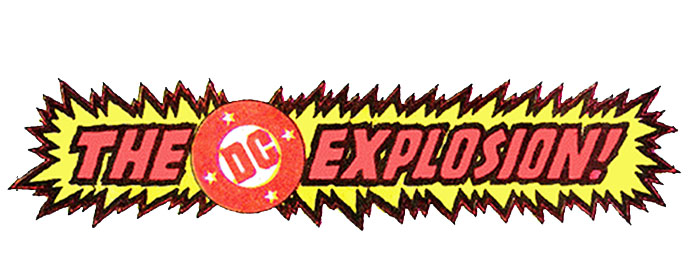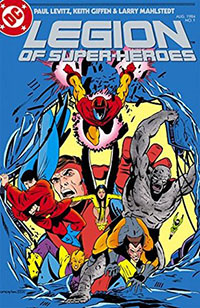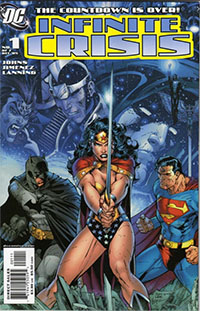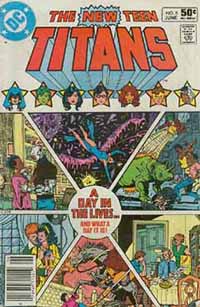Comics /
Cult Favorite
DC Implosion, 2.0, part 1: Evaluating the Past

By Philip Schweier
August 19, 2020 - 09:40
Last year, AT&T purchased DC Entertainment’s parent company, Time/Warner, for more than $100 billion. But as Covid-19 has taken its toll on the economy, there are reports that there is not enough net cash flow being generated to service the immense debt, and the total market value of net assets are now worth less than its total loans. No doubt in a bid to reduce costs and maximize profits, AT&T initiated massive layoffs throughout many of its corporate subsidiaries.
 |
| DC publisher Jim Lee |
Last week, fans, retailers and professionals were stunned by the gutting of DC’s editorial staff. When the music stopped, it appeared the only high-level executive to still have a chair at the table was publisher Jim Lee. While 2020 has been a rough year for everyone, it’s especially troublesome to suddenly find one’s career in a relatively small industry come to such a sudden and dramatic end.
However, there were recent warning signs that changes were coming. Comic book publishing no longer exists in a small but sustainable bubble, as characters are leveraged to support major film franchises, and all the toys, merchandise and Happy Meals® that accompany such efforts. For more than a decade, DC has struggled to match the major marketing advancement of its perennial competitor, Marvel Comics. Not only have DC properties been unable to match the output of Marvel Studios films, relatively few have achieved much in the way of box office success.
Last spring, long-time DC publisher Dan DiDio was terminated. This summer, the DC Universe streaming service ended its yearly subscription option, hinting that the service’s future was in doubt. It was later announced that its original programming would migrate to corporate sibling HBO Max.
So, yes, change was clearly coming. Frankly, my only surprise is it didn’t happen sooner.
 |
| The Legion of Super-Heroes was one of DC's best selling titles in the 1980s, and continues to cultivate devoted fans. |
In the 1970s, I grew up on DC Comics. I dabbled briefly with Marvel titles, but mostly just to determine my level of interest. The one that appealed to me most was
Conan the Barbarian. DC titles such as
The Warlord and
Legion of Super-Heroes held my attention much more consistently.
Fellow fans were sometimes critical of DC’s efforts, arguing that Marvel was “more real.” I can’t disagree, but when discussing super-powered beings wearing costumes and fighting crime, reality hardly enters the conversation. DC’s childish innocence appealed to me; it was all part of the fantasy, however juvenile it may be.
Another criticism was that the DC Universe was bogged down with too many characters, and multiple iterations of the same characters.
Crisis on Infinite Earths in 1984 attempted to streamline it all, but as a long-time fan, such a compression seemed unnecessary to me.
I abandoned comics in general shortly afterward, for various reasons, among which was frustration at the constant hype regarding “event stories.” Superman died, then he got married, then his powers and costume were radically changed, then changed back. Jason Todd was killed, then Batman was catastrophically injured, then Jason Todd was resurrected. Green Lantern turned evil.
For the next decade or so, I observed an effort to re-imagine B-list heroes – Flash, Green Lantern and Green Arrow – by replacing them with new, younger replacements. Some may disagree, but these events held little substance, none of which promised any long-lasting change.
When I came back a few years later, the landscape had changed, to no surprise. I didn’t jump back in with both feet, but waded cautiously, because I had witnessed too many disappointing missteps. DC had begun to rebuild its universe, resurrecting the classic versions of Barry Allen, Hal Jordan and Oliver Queen.
Once pillars were in place, DC continued tinkering with its Universe with an endless series of major event major event stories.
Identity Crisis (2004),
Infinite Crisis (2005), and
Final Crisis (2008). Fans began to feel no small exhaustion from it all. With so many storylines crossing over from one title to another, it stretched the budget of many passionate fans, and diminished the interest of casual readers. According to Wikipedia, the entire
Infinite Crisis saga – including prologues, crossovers, tie-ins and epilogues – encompassed 178 individual comic books.
When none of this failed to generate the success DC was aiming for, it resorted to a reboot of the entire DC Universe (except Batman, for some reason). With the New 52 now in the rearview, it’s easy to play Monday morning quarterback and criticize such efforts. But where DC most notably went wrong was failing to meet the most basic business strategy for a comic book publisher:
Tell. Good. Stories.
Not GREAT stories, not BIG stories, but good stories.
From the perspective of a consumer, it’s really that simple. Offer a good product, establish a reliable customer base, and build on success, one month at a time.
For example, one of the most successful titles of the past 50 years was the
New Teen Titans, launched in 1980 by writer Marv Wolfman and artist George Perez. And one of the most noteworthy stories was “A Day in the Life…” (
New Teen Titans #8, June, 1981). It was a simple, single-issue story that examined the more personal moments among the Teen Titans.
It’s a story that DC Comics would not tell today. It lacks the scope of more recent offerings involving scores of DC characters united against yet another cosmic threat. I can appreciate creating an ambitious epic, but when they come so fast, one after another after another, event fatigue sets in.
Another storytelling flaw DC seemed to embrace was its constant expanding of any given supporting cast. Rather than continue to develop existing characters, DC editorial seemed inclined to add someone new, only to search for a means to incorporate them into the greater narrative.
Certainly the
Daily Planet needs a staff of more than Perry White, Clark Kent, Lois Lane and Jimmy Olsen. But how many sidekicks does Batman need? Has Bruce Wayne become so old and enfeebled he needs to delegate his bat duties? With an entire galaxy of Green Lanterns, why continuously create more? The only purpose they seem to fill is to crowd the panels of a 22-page comic book.
No doubt there are insiders far more familiar with the internal goings-on at DC, TimeWarner and AT&T who would dismiss my observations as uninformed. I’ll agree I posses no special insight; my only perspective is as a customer. But that doesn’t make my assessments any less valid. When two decades of missteps, mistakes and mismanagement alienate fans and professionals alike, it’s clear something is amiss that can’t be easily fixed.
Last Updated: March 3, 2025 - 20:40




